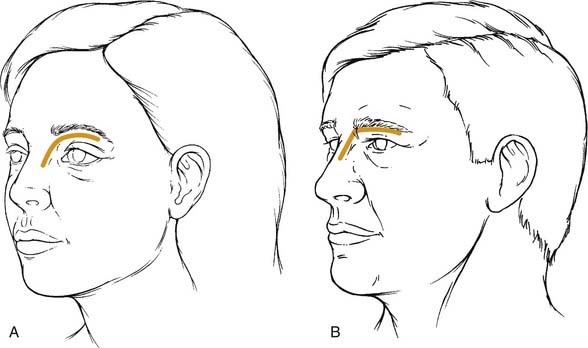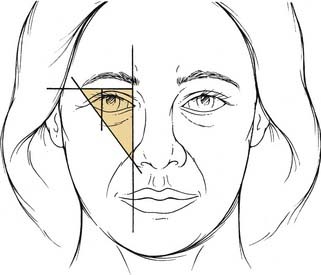CHAPTER 29 Rejuvenation of the Aging Brow and Forehead
Proportions of the Aesthetic Brow and Forehead
The forehead, from the eyebrows to the hairline, makes up the upper third of the face. The aesthetically favored forehead produces a gentle convexity on profile. Other shapes include sloping, flat, and protruding. The eyebrows generally follow a smooth, gently curving arc that extends from the lateral eyebrow around the nasion and down the lateral nasal sidewall (Fig. 29-1A). In women, the eyebrow should lie slightly above the supraorbital rim and follow a gently curving arc (Fig. 29-2). The eyebrow begins at a line drawn from the alar-facial groove through the medial canthus and ends at a line drawn from the alar-facial groove through the lateral canthus.1 In women, the highest point of the eyebrow arc is at a line drawn tangential to the lateral limbus. The medial and lateral ends of the eyebrow should lie in a horizontal line. The medial end should have a clublike configuration that gradually tapers laterally. In men, the brow usually lies at the level of the supraorbital rim (see Fig. 29-1B).

Figure 29-1. A, Smooth, gently curving line extending from eyebrow to nose. B, Sharp angle between eyebrow and nose.
(Adapted from Nassif PS, Kokoska MS. Aesthetic facial analysis. Facial Plast Surg Clin North Am 1999;7:1.
The Aging Brow and Forehead
Although different regions of the face age at variable rates and are influenced primarily by genetic factors, the upper third of the face ages in its own unique fashion (Fig. 29-3).2 As skin elasticity declines, the forehead, temple, and glabellar skin descend. The brow, especially in its temporal aspect, descends to or below the supraorbital rim with the effects of gravity causing temporal hooding. If brow ptosis is severe, a visual deficit may develop in the superior and temporal quadrant. The supratarsal crease disappears by overhanging ptotic upper eyelid skin. Crow’s feet (rhytids at the lateral canthus) appear secondary to gravity and repeated contraction of the orbicularis oculi muscle. Deep forehead creases appear due to the repetitive actions of the primary brow elevator, the frontalis muscle, in an effort to elevate the heavy, ptotic brow. Vertical, oblique, and horizontal rhytids appear in the glabella and nasion from contractions of the brow depressors—the corrugator, procerus, and depressor supercilii muscles.
Patient Selection
Psychological Considerations
As with any facial plastic surgery procedure, careful patient selection is paramount. Realistic expectations and proper motivations of the patient are extremely important in achieving a successful outcome, a satisfied patient, and a pleased facial plastic surgeon. If the surgeon despite a visually pleasing surgical result does not perform proper patient screening, patient dissatisfaction may be encountered. Educating patients about the different surgical procedures and goals requires excellent physician-patient communication and guidance. Computer imaging of the proposed brow elevation may enhance the communication of surgical goals because few patients are aware that brow ptosis is responsible for their orbital changes. Often, patients think and are told that droopy eyelid skin in the presence of a ptotic brow is the cause of their “saddened” look. If upper blepharoplasty is performed in this situation, the eyebrow-lid margin is potentially narrowed, obliterating adequate delineation of the supratarsal anatomy by sacrificing excessive upper eyelid skin.3 Following the education process, candidates for aging brow surgery must give informed consent after discussing possible adverse outcomes, complications, and risks of the selected surgical procedure.
Anatomic Considerations
Analysis of the upper third of the face, from the eyebrows to the hairline, should begin with the assessment of interpersonal factors that may significantly affect the patient’s interpretation of successful surgical intervention and, as such, must be carefully examined. Age, gender, race, body habitus, and personality are the main interpersonal components that must be considered when assessing the eyebrow complex.4
Surgical Goals
The goals associated with rejuvenation surgery of the brow and upper third of the face include the following5:
Surgical Techniques
Traditional methods of forehead and brow rejuvenation, such as coronal, pretrichal, and direct brow lifts have provided facial plastic surgeons with effective brow elevation for many years. In the past decade, the endoscopic forehead and brow lift has rapidly become accepted as part of the surgical armamentarium and is frequently the technique of choice.6–8 The indications and contraindications for each forehead and brow-lifting procedure are described in Table 29-1.5
Table 29-1 Indications and Contraindications for Individual Forehead and Brow-Lifting Procedures
| Procedure | Indications and Advantages | Contraindications and Disadvantages |
|---|---|---|
| Coronal forehead lift | Treats all aspects of aging forehead and brow | |
| Pretrichal forehead lift | ||
| Midforehead lift | ||
| Midforehead brow lift | ||
| Direct brow lift | ||
| Temporal lift | ||
| Browpexy |





